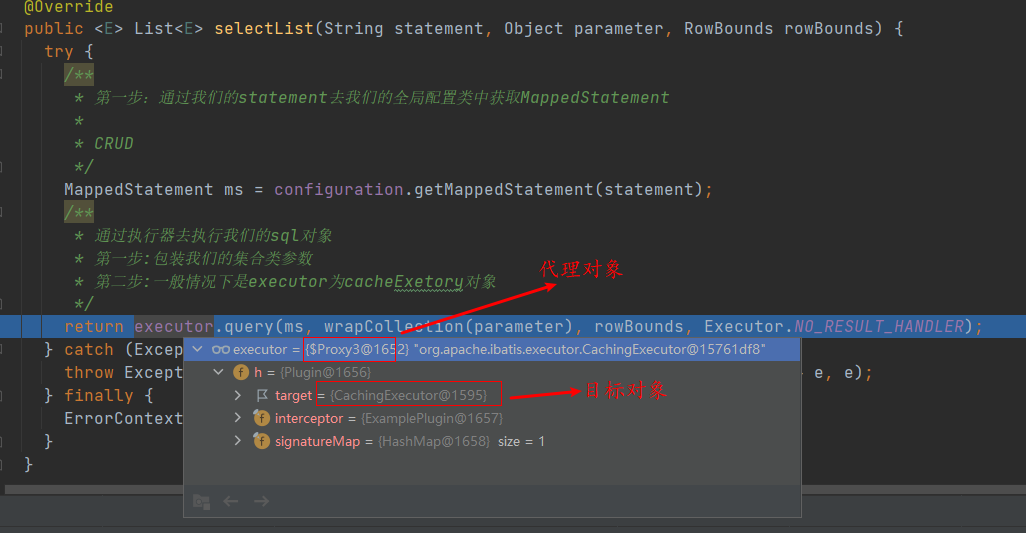mybatis-plugin插件
寻找的路上 人气:0mybatis-plugin插件执行原理
今天主要是在看mybatis的主流程源码,其中比较感兴趣的是mybatis的plugin功能,这里主要记录下mybatis-plugin的插件功能原理。
plugin集合列表:在构建SqlSessionFactory时,通过解析配置或者plugin-bean的注入,会将所有的mybatis-plugin都收集到Configuration
对象的interceptorChain属性中。InterceptorChain类定义如下:
public class InterceptorChain {
private final List<Interceptor> interceptors = new ArrayList<>();
public Object pluginAll(Object target) {
for (Interceptor interceptor : interceptors) {
target = interceptor.plugin(target);
}
return target;
}
public void addInterceptor(Interceptor interceptor) {
interceptors.add(interceptor);
}
public List<Interceptor> getInterceptors() {
return Collections.unmodifiableList(interceptors);
}
}plugin作用对象:Executor,ParameterHandler,ResultSetHandler,StatementHandler,这4个对象在mybatis执行sql的过程中
有不同的作用。
Executor:sql执行的具体操作对象。
ParameterHandler:sql执行前的参数处理对象。
ResultSetHandler:sql执行后的结果集处理对象。
StatementHandler:具体送到数据库执行的sql操作对象。
plugin作用原理:类似AOP,使用JDK动态代理,只不过mybatis的增强对象不是所有对象,而是上面陈列的4个对象而已。
在4个对象创建时,都会对各个对象进行判断,是否需要进行插件化。比如下面的插件:
@Intercepts({@Signature( type= Executor.class, method = "query", args ={
MappedStatement.class, Object.class, RowBounds.class, ResultHandler.class
})})
public class ExamplePlugin implements Interceptor {
// 分页 读写分离 Select 增删改
public Object intercept(Invocation invocation) throws Throwable {
System.out.println("代理");
Object[] args = invocation.getArgs();
MappedStatement ms= (MappedStatement) args[0];
// 执行下一个拦截器、直到尽头
return invocation.proceed();
}
}该插件将会在Executor该对象创建时,使用该插件进行增强。在新开一个sqlSession时,将会创建Executor对象。跟踪到具体方法:
public Executor newExecutor(Transaction transaction, ExecutorType executorType) {
executorType = executorType == null ? defaultExecutorType : executorType;
executorType = executorType == null ? ExecutorType.SIMPLE : executorType;
Executor executor;
/**
* 判断执行器的类型
* 批量的执行器
*/
if (ExecutorType.BATCH == executorType) {
executor = new BatchExecutor(this, transaction);
} else if (ExecutorType.REUSE == executorType) {
//可重复使用的执行器
executor = new ReuseExecutor(this, transaction);
} else {
//简单的sql执行器对象
executor = new SimpleExecutor(this, transaction);
}
//判断mybatis的全局配置文件是否开启缓存
if (cacheEnabled) {
//把当前的简单的执行器包装成一个CachingExecutor
executor = new CachingExecutor(executor);
}
/**
* TODO:调用所有的拦截器对象plugin方法
* 插件: 责任链+ 装饰器模式(动态代理)
*/
executor = (Executor) interceptorChain.pluginAll(executor);
return executor;
}我们找到interceptorChain.pluginAll方法:
public Object pluginAll(Object target) {
for (Interceptor interceptor : interceptors) {
target = interceptor.plugin(target);
}
return target;
}发现会通过已加载的所有plugin列表中,逐个遍历去筛选出符合Executor类型的插件,再通过具体插件的interceptor.plugin方法去创建
Executor的代理对象。
public interface Interceptor {
Object intercept(Invocation invocation) throws Throwable;
default Object plugin(Object target) {
return Plugin.wrap(target, this);
}
default void setProperties(Properties properties) {
// NOP
}
}再看到具体的Plugin.wrap(target, this)方法:
public static Object wrap(Object target, Interceptor interceptor) {
// 获得interceptor配置的@Signature的type
Map<Class<?>, Set<Method>> signatureMap = getSignatureMap(interceptor);
// 当前代理类型
Class<?> type = target.getClass();
// 根据当前代理类型 和 @signature指定的type进行配对, 配对成功则可以代理
Class<?>[] interfaces = getAllInterfaces(type, signatureMap);
if (interfaces.length > 0) {
return Proxy.newProxyInstance(
type.getClassLoader(),
interfaces,
new Plugin(target, interceptor, signatureMap));
}
return target;
}这里我们就很清楚了,通过@Signature注解上的type、method、args属性去匹配,如果找到符合的,就会为对象创建代理对象,并返回代理对象。
责任链设计模式:因为一个增强对象可能会有多个plugin的增强逻辑,所以在执行的时候使用的是责任链设计模式。

因为Plugin.wrap()方法新建的代理对象中使用的InvocationHandler对象是Plugin本身,所以在执行方法的时候首先要调用它的invoke方法,
@Override
public Object invoke(Object proxy, Method method, Object[] args) throws Throwable {
try {
Set<Method> methods = signatureMap.get(method.getDeclaringClass());
if (methods != null && methods.contains(method)) {
return interceptor.intercept(new Invocation(target, method, args));
}
return method.invoke(target, args);
} catch (Exception e) {
throw ExceptionUtil.unwrapThrowable(e);
}
}当我们执行Executor的query方法时,符合if (methods != null && methods.contains(method)) {条件,这时就会去执行具体插件的增强方法,interceptor.intercept,
然后再通过传递new Invocation(target, method, args)对象,在插件执行完之后,再调用invocation.proceed()去执行下一个插件逻辑。
如下是对Executor的query方法添加了2个插件的场景:

总结:如果我们的业务需要我们去编写sql插件,那我们就需要来研究下Executor,ParameterHandler,ResultSetHandler,StatementHandler这4个对象的具体跟sql相关的方法,
然后再进行修改,就可以直接起到aop的作用。
加载全部内容